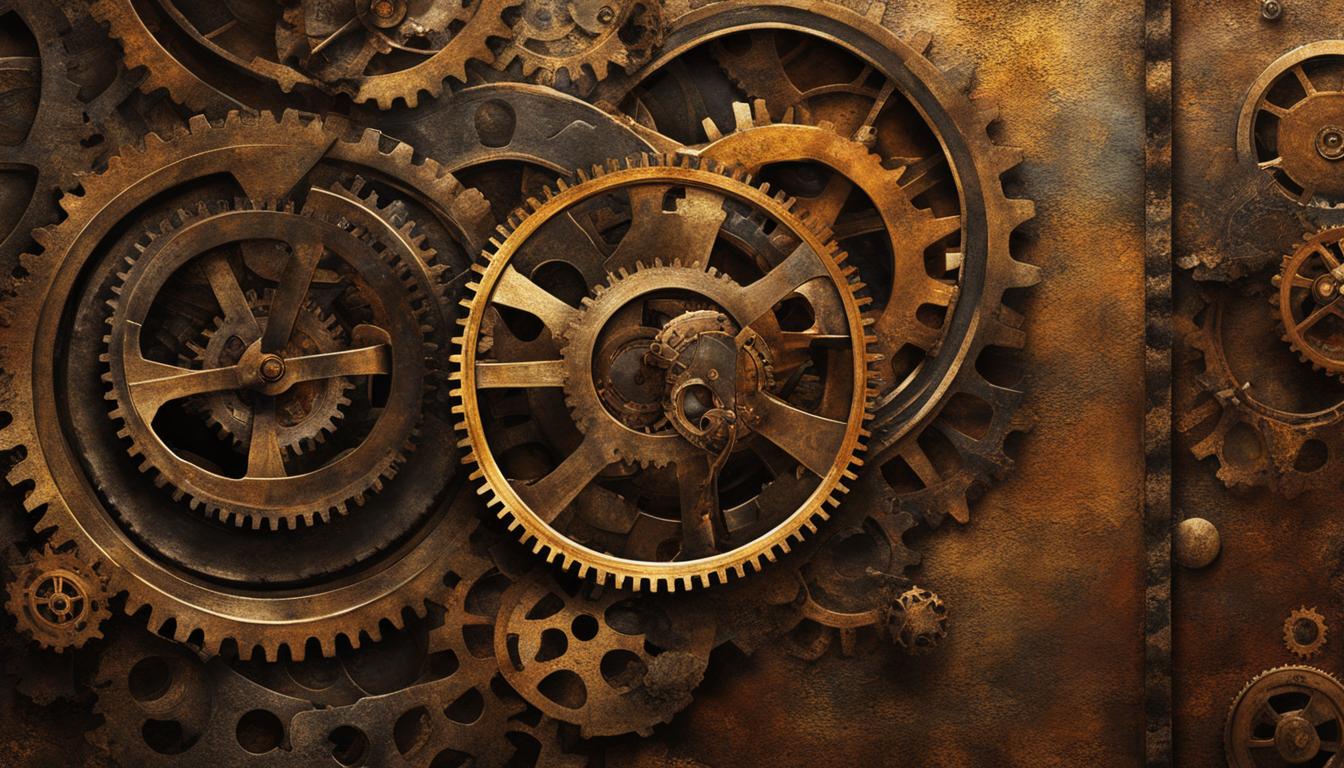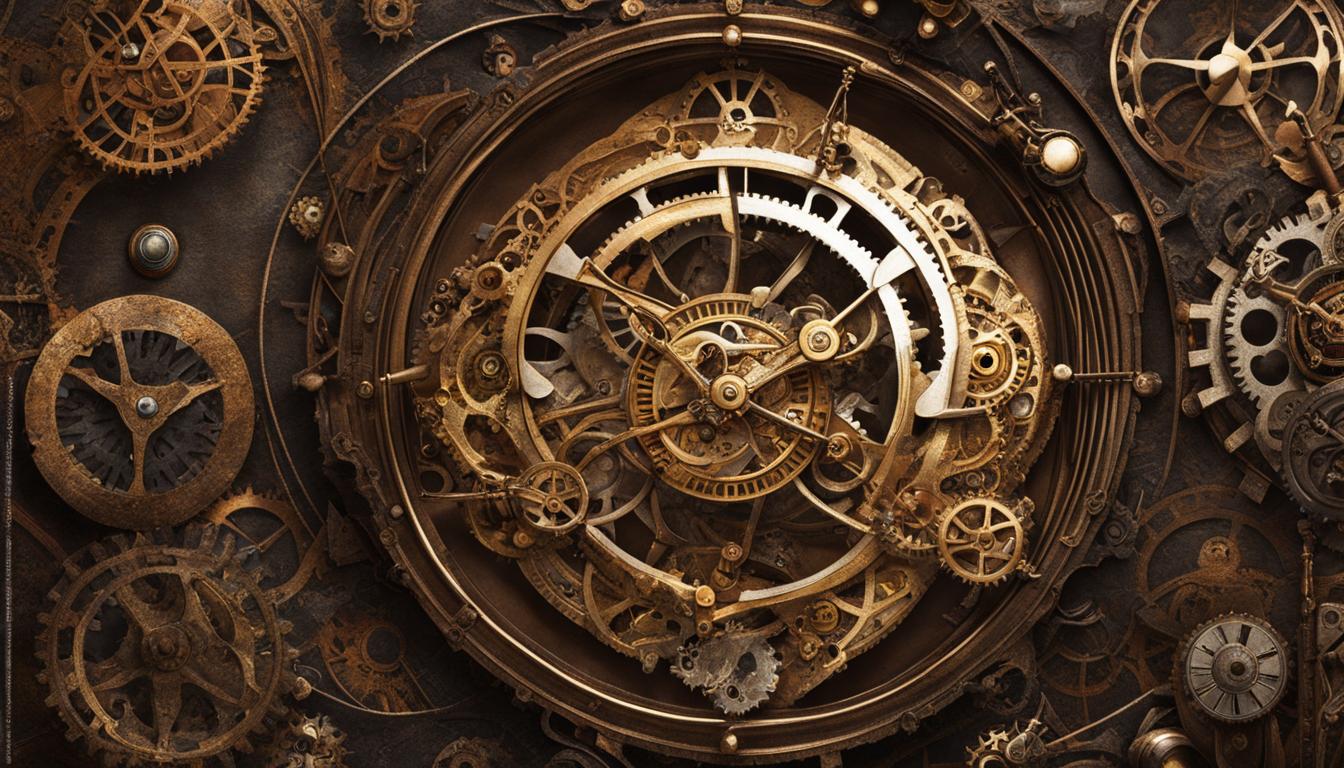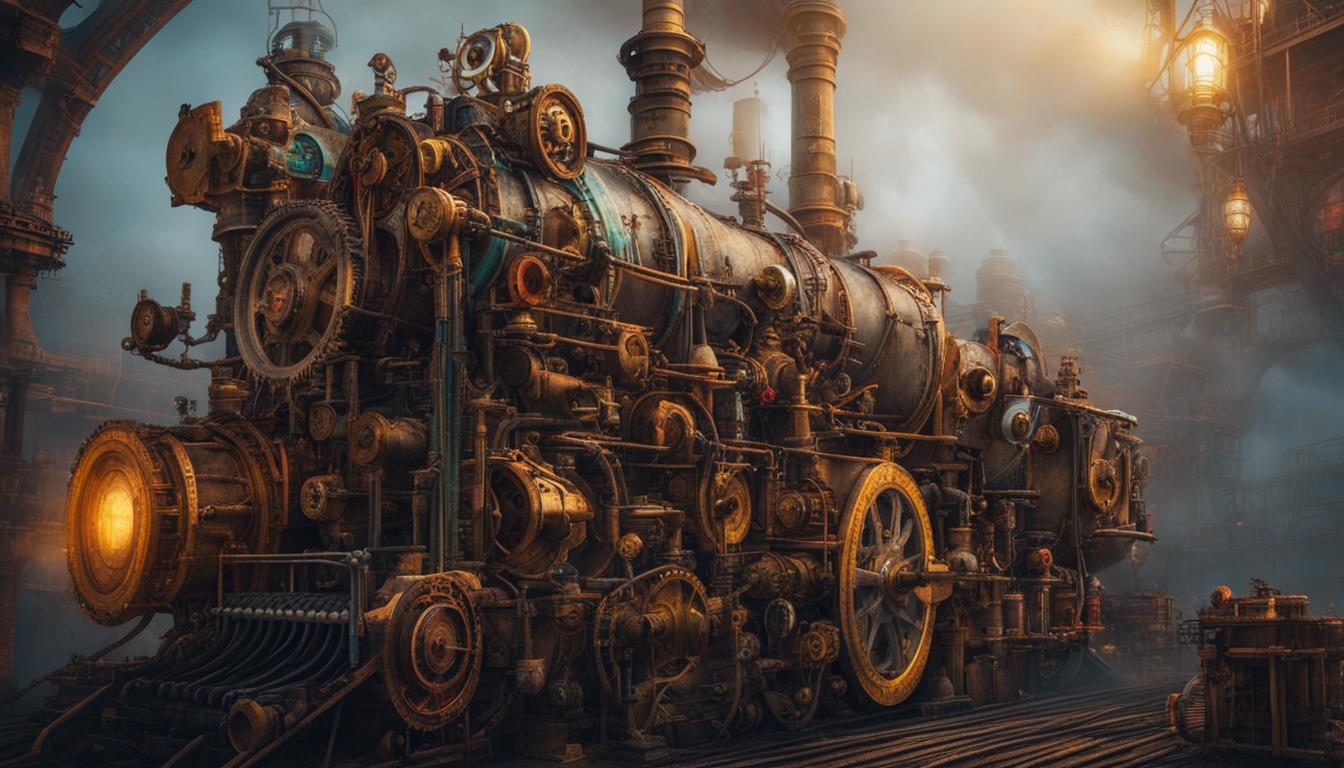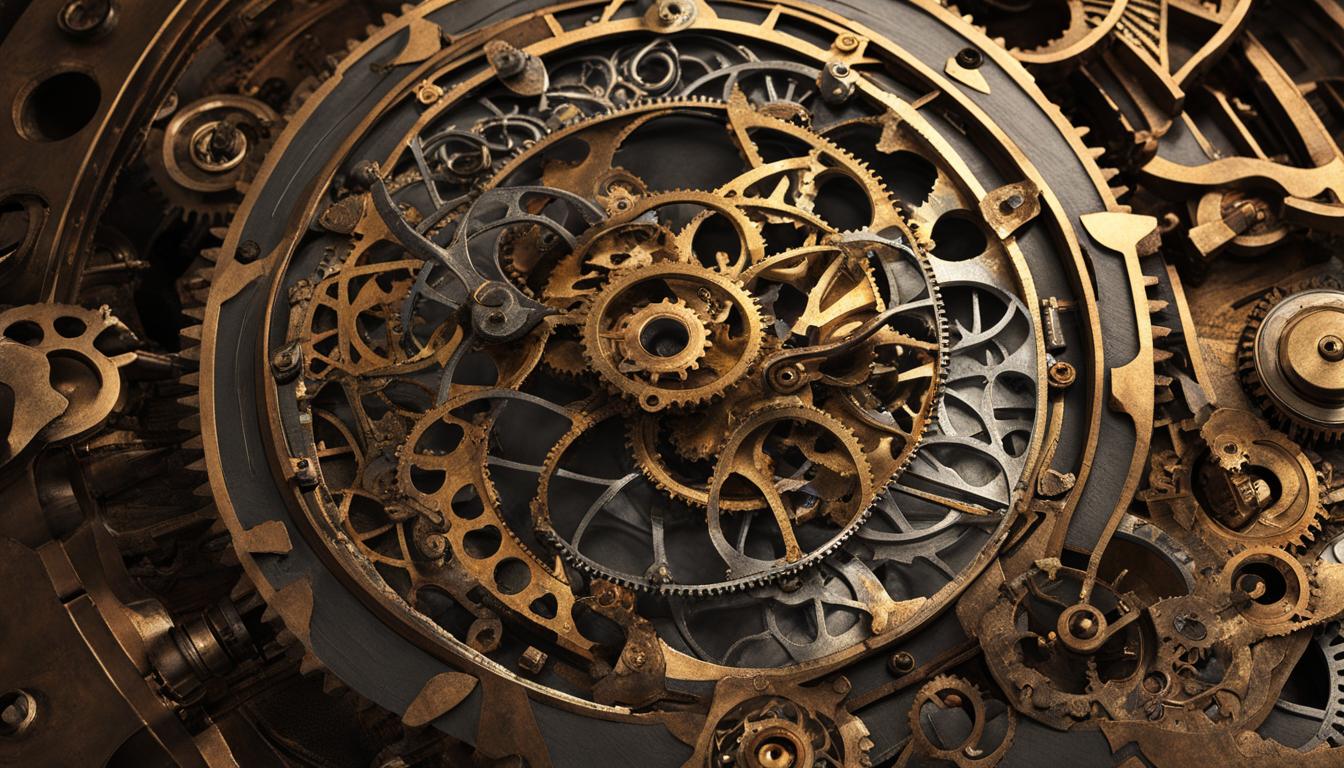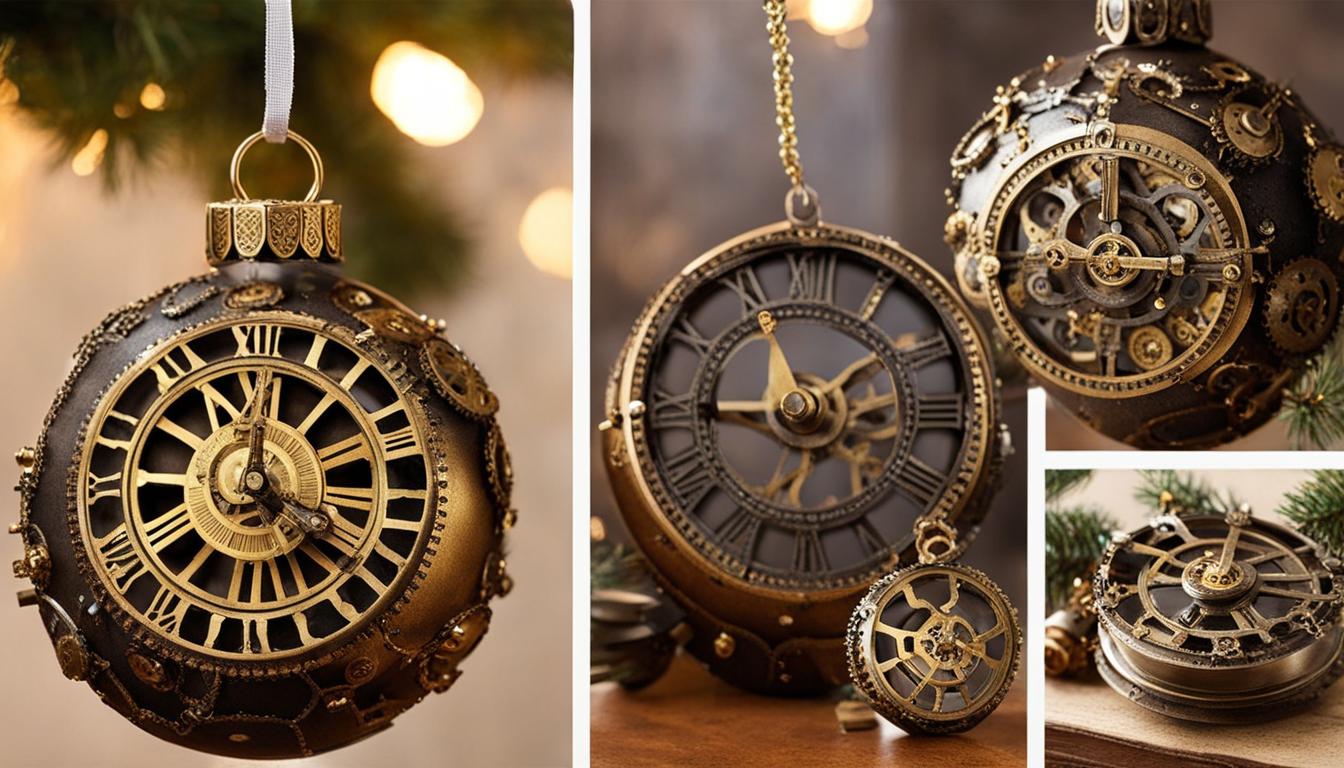Steampunk, a captivating sub-genre of science fiction, blends 19th-century technology and aesthetics with a touch of fantasy. From home decor to fashion and crafts, steampunk projects offer a world of creativity and imagination. When it comes to painting and finishing your steampunk creations, there are numerous techniques and materials that can help you achieve the desired look.
Are you ready to unlock the secrets of steampunk painting? In this article, we will delve into the fascinating world of steampunk artistry, providing you with the knowledge and inspiration you need to create stunning and authentic steampunk pieces. Whether you’re a seasoned artist or a DIY enthusiast, these techniques and tips will guide you in painting and finishing your very own steampunk masterpieces.
Key Takeaways:
- Learn various techniques and materials to achieve the steampunk aesthetic in your paintings.
- Embrace mechanical elements, metals, and vintage items to add authenticity to your steampunk creations.
- Pay attention to detail and depth to enhance the captivating allure of steampunk art.
- Experiment with color palettes to set the mood and bring your steampunk creations to life.
- Use acrylic mediums and finishes to add texture and protect your steampunk projects.
Understanding the Steampunk Aesthetic
Steampunk, with its fusion of Victorian elegance and industrial steam-powered machinery, is a captivating aesthetic that has gained popularity in various art forms. When it comes to painting steampunk items, it’s essential to understand the key elements that define this unique style.
Incorporating mechanical elements like gears, cogs, and levers can instantly bring the steampunk vibe to your artwork. These industrial components not only add visual interest but also create a sense of functionality and movement. Don’t shy away from embracing metals like copper and brass, which not only contribute to the industrial feel but also provide warmth and depth to your designs.
Authenticity is a vital aspect of steampunk art, and vintage items such as typewriters and pocket watches can play a significant role in achieving this. These items not only bring a sense of nostalgia but also add a touch of antiquity to your creations. Let your imagination soar as you infuse fantastical elements into the mix, allowing you to truly capture the essence of steampunk.
“Incorporate mechanical elements like gears, cogs, and levers to bring the steampunk vibe to your artwork.”
Steampunk is a style that encourages creativity and experimentation. Feel free to push the boundaries and incorporate your own unique twists, whether it’s through the use of unconventional materials, unexpected combinations, or imaginative storytelling. By understanding and embracing the steampunk aesthetic, you can unlock a world of possibilities and create awe-inspiring paintings that transport viewers to a bygone era infused with fantasy.
Table: Key Elements of the Steampunk Aesthetic
| Element | Description |
|---|---|
| Mechanical Elements | Gears, cogs, levers, and other mechanical components that evoke functionality and movement. |
| Metals | Copper and brass add an industrial feel and warmth to steampunk artwork. |
| Vintage Items | Typewriters, pocket watches, and other nostalgic items add authenticity and antiquity. |
| Fantastical Elements | Infuse your artwork with imaginative and fantastical elements to capture the essence of steampunk. |
Exploring Steampunk Project Materials
When it comes to creating stunning steampunk crafts, the choice of materials plays a crucial role. To achieve an authentic and captivating steampunk aesthetic, incorporating unique and industrial components is essential. Here are some materials that can bring your steampunk projects to life:
Gears, Cogs, and Clock Parts
One of the defining features of steampunk is its mechanical elements. Look for cogwheels, screws, clock parts, and other intricate components to add an industrial touch to your creations. These elements can be found in craft stores, but for a more authentic look, consider sourcing aged and textured metal parts from auto mechanics, industrial workshops, or flea markets. The slight wear and tear on these pieces will add character and enhance the overall steampunk aesthetic of your projects.
Metal Embellishments
Metal embellishments are another essential element in steampunk creations. Look for brass charms, vintage keys, and small metal trinkets that can be incorporated into your designs. These details provide a layer of authenticity and visual interest to your projects. You can also experiment with various finishes, such as oxidized or rusted metal, to achieve a weathered and aged look.
Industrial Textiles
When it comes to steampunk fashion and home decor, don’t forget about the textiles. Look for fabrics with an industrial or Victorian feel, such as tweed, leather, lace, or brocade. These materials can be used for clothing, accessories, upholstery, or even as backdrops for your steampunk displays. Consider adding texture to your projects through pleating, ruffles, or unique stitching patterns to further enhance the overall steampunk aesthetic.
By incorporating these materials into your steampunk projects, you can create visually captivating and authentic pieces that embody the essence of the steampunk genre. Embrace the industrial nature of steampunk by incorporating gears, cogs, and clock parts. Add a touch of elegance with brass embellishments and vintage textiles. Let your creativity soar as you explore the possibilities of steampunk project materials.
Essential Acrylic Mediums for Steampunk Painting
When it comes to painting your steampunk creations, using the right acrylic mediums is essential to achieve the desired look. These mediums not only enhance the painting process but also help create unique textures and finishes that are characteristic of the steampunk aesthetic.
Gesso: Gesso is a primer similar to white acrylic paint that provides a textured surface for painting. It not only prepares your project for painting but also helps the acrylic paint adhere better, ensuring a smooth and long-lasting finish.
Gel Medium: If you’re looking to attach heavy metal parts to your steampunk pieces, gel medium is your best friend. Particularly, heavy gel medium provides a strong bond and holds the metal securely in place, allowing you to create intricate and visually captivating designs.
Acrylic Paints: Acrylic paints are the go-to choice for adding base colors to your steampunk projects. Whether you’re using regular acrylic paints or metallic ones, they offer a wide range of shades and finishes to bring your creations to life. Experiment with different colors and layering techniques to achieve depth and complexity in your artwork.
Finishing Paints: To give your steampunk creations a final touch, consider using finishing paints such as waxes or rust paints. These paints replicate the look of metals or aged surfaces, adding a touch of authenticity and a vintage feel to your pieces.
Sprays and Texture Mediums: In addition to the acrylic mediums mentioned above, don’t forget to explore the use of sprays and texture mediums. These products can help you enhance the steampunk aesthetic by adding texture, weathering effects, or even creating a rusty appearance. Experiment with different techniques to achieve the desired look for your steampunk projects.
The right combination of these essential acrylic mediums will allow you to bring your steampunk visions to life. Whether you’re painting a canvas, modifying an item, or creating a unique piece from scratch, these techniques and materials will help you achieve stunning results. So, grab your brushes and embark on a journey into the enchanting world of steampunk painting!
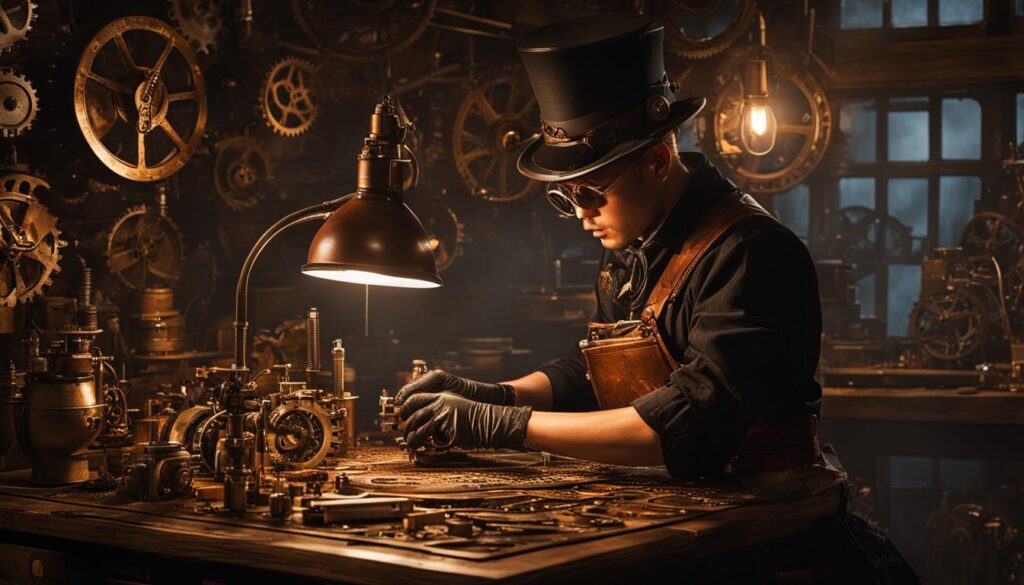
Table: Essential Acrylic Mediums for Steampunk Painting
| Acrylic Medium | Usage |
|---|---|
| Gesso | Provides a textured surface for painting and improves paint adhesion |
| Gel Medium | Perfect for attaching heavy metal parts securely |
| Acrylic Paints | Used for adding base colors and creating depth in steampunk projects |
| Finishing Paints | Adds a metallic or vintage finish to steampunk creations |
| Sprays and Texture Mediums | Enhances the steampunk aesthetic with texture and weathering effects |
Adding Detail and Depth in Steampunk Painting
When it comes to creating stunning steampunk paintings, adding detail and depth is essential. It’s the little intricacies and nuances that bring your artwork to life and captivate viewers. By incorporating various techniques and elements, you can achieve a truly mesmerizing steampunk aesthetic. Whether you’re painting a canvas, customizing a piece of furniture, or transforming everyday objects into steampunk masterpieces, these tips will help you elevate your art to the next level.
Embrace Analog Design Elements
One of the key ways to add detail and depth to your steampunk paintings is by embracing analog design elements. Gears, cogs, and clocks are iconic symbols of steampunk and can instantly transform your artwork. Incorporate these mechanical elements strategically, placing them in areas where they draw the eye and create a sense of movement. Experiment with different sizes and styles of gears to add dimension and intrigue. The intricate details of analog elements help to convey the essence of a bygone era of Victorian elegance and industrial revolution.
Textures and Patterns for Visual Interest
Textures and patterns are powerful tools that can create visual interest and enhance the depth of your steampunk paintings. Experiment with combining wood and metal textures to evoke the fusion of natural and industrial elements that define steampunk. Use dry brushing techniques to create weathered effects or add rust and corrosion to convey the passage of time. Integrate patterns like cogwheel motifs or intricate clockwork designs to further enhance the authenticity of your artwork. These subtle details can make a significant impact on the overall aesthetic of your steampunk pieces.
Layering for Depth and Complexity
Layering is a technique that adds depth and complexity to your steampunk paintings. Start by creating a base layer with your chosen colors, then gradually build upon it with additional layers of paint and details. This process allows you to create depth by highlighting certain areas while adding shadows and shading to others. Experiment with different opacities and blending techniques to create a sense of dimensionality. Layering not only adds visual interest but also adds a sense of mystery and intrigue to your steampunk artwork.
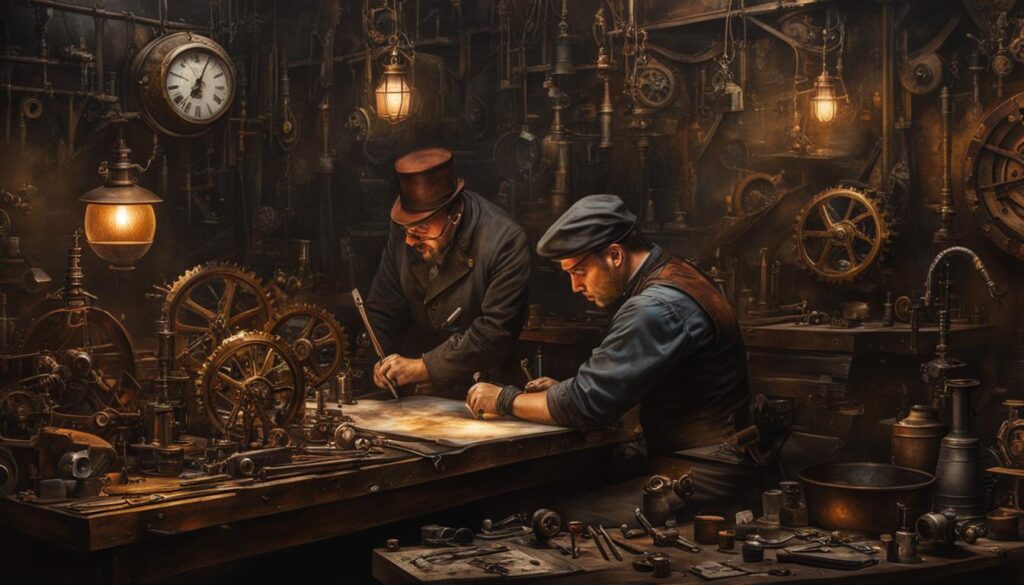
By incorporating these tips into your steampunk painting process, you can take your artwork to new heights. Remember to embrace analog design elements, experiment with textures and patterns, and utilize layering techniques to add depth and complexity. Let your creativity run wild as you bring the mesmerizing world of steampunk to life on your canvas, furniture, or everyday objects. With attention to detail and a touch of mystery, your steampunk paintings are sure to captivate and inspire.
Exploring Steampunk Color Palettes
When it comes to capturing the essence of steampunk in your paintings, choosing the right color palette is essential. While traditional warm, earthy tones like deep browns and aged brass are commonly used, don’t be afraid to experiment with different color combinations to bring a unique twist to your steampunk creations. Here are a few examples of potential color palettes that can give your paintings a captivating steampunk style:
Brass and Sapphire
Combining the rich, warm tones of brass with the deep, vibrant hues of sapphire creates a striking contrast that reflects the elegance and mystery of steampunk. Use brass as the dominant color and accentuate it with pops of sapphire to bring depth and visual interest to your paintings.
Charcoal and Gold
For a more industrial and grungy feel, consider using a color palette of charcoal and gold. Charcoal provides a dark and moody base, while gold adds a touch of luxury and sophistication. This combination is perfect for capturing the rugged and mechanical elements of steampunk.
Teal and Copper
If you’re looking for a color palette that evokes a sense of adventure and exploration, teal and copper are an excellent choice. Teal represents the open skies and vast oceans, while copper adds warmth and a metallic touch. This combination creates a dynamic and vibrant atmosphere in your steampunk paintings.
Burgundy and Cream
For a more vintage and refined steampunk look, opt for a color palette of burgundy and cream. Burgundy exudes richness and elegance, while cream adds a soft and feminine touch. This combination is perfect for capturing the Victorian era influences in your steampunk paintings.
Remember, the choice of color palette sets the mood and brings your steampunk creations to life. Don’t be afraid to experiment with different combinations and let your creativity soar as you dive into the mystical world of steampunk painting techniques.
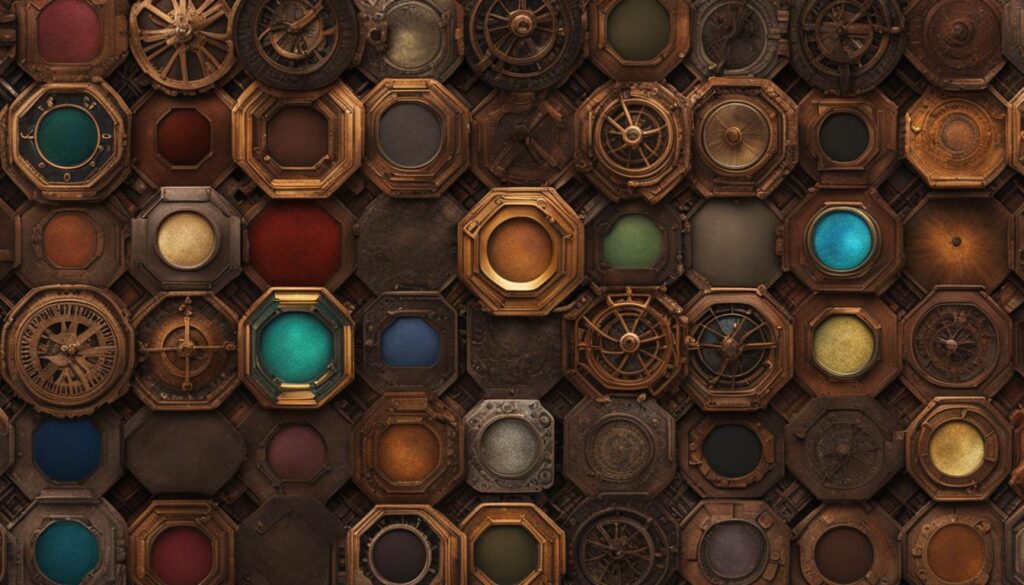
| Color Palette | Description |
|---|---|
| Brass and Sapphire | A combination of rich brass and vibrant sapphire for an elegant and mysterious steampunk look. |
| Charcoal and Gold | A mix of dark charcoal and luxurious gold for a rugged and industrial steampunk feel. |
| Teal and Copper | Teal paired with warm copper to create an adventurous and dynamic steampunk atmosphere. |
| Burgundy and Cream | Burgundy and cream for a vintage and refined steampunk aesthetic inspired by the Victorian era. |
Creating Steampunk Projects with Paint
To bring your steampunk creations to life, mastering the art of painting and finishing is essential. By following these techniques, you can transform ordinary objects into stunning steampunk masterpieces.
Start by preparing your surface with a matte gray spray primer or a neutral-colored spray paint. This creates a smooth base and helps the paint adhere better. Next, apply acrylic paints in your desired base colors. Whether you opt for regular acrylic paints or metallic ones for a shimmering effect, let your creativity guide you.
To add texture and weathering to your steampunk creations, consider techniques like dry brushing. This involves using a mostly dry brush to apply paint in a light, sweeping motion, emphasizing raised surfaces and edges. Another option is to use texture mediums, such as crackle paste or rust paint, to achieve a weathered or rusty look.
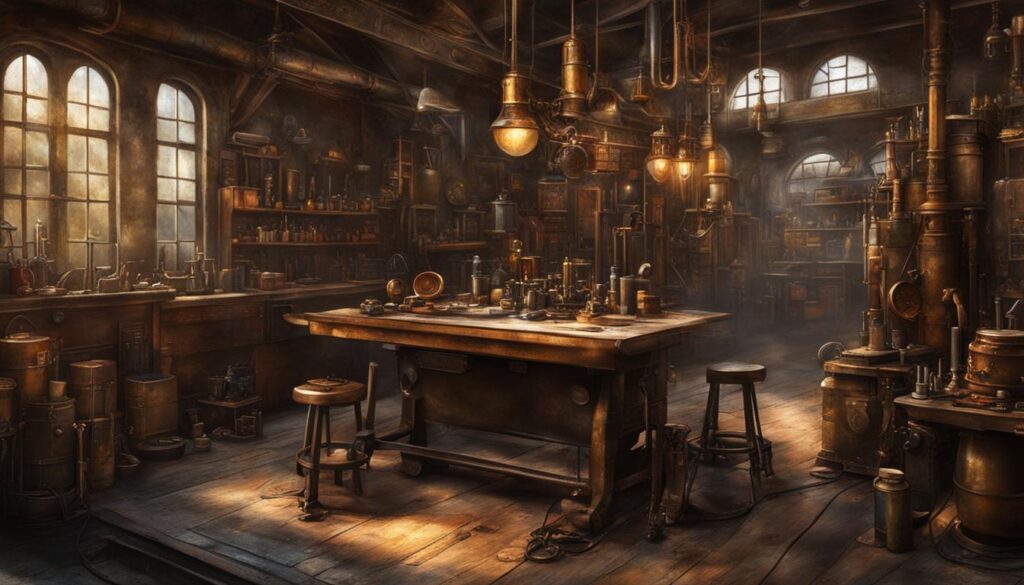
Once your paintwork is complete, it’s important to seal your project to protect it from chipping or smearing. Use a spray sealer or Mod Podge to provide a protective layer that will ensure your steampunk creation stands the test of time.
Conclusion
The world of steampunk painting is a fascinating realm where creativity knows no bounds. By mastering the art of steampunk paint finishing techniques, you can transform your ordinary crafts into exceptional works of art that exude mystery and allure.
Creating finishes on steampunk crafts is all about capturing the essence of this unique sub-genre. Embrace the mesmerizing blend of Victorian elegance and industrial machinery by incorporating metallic elements like gears, cogs, and vintage clock parts.
Attention to detail is paramount in achieving the authentic steampunk look. Explore various techniques such as dry brushing or texture mediums to add depth and complexity to your creations. Experiment with color palettes that evoke the industrial and fantastical aspects of steampunk, like sapphire and brass or burgundy and cream.
With the right materials and a touch of imagination, you can bring your steampunk visions to life. So, let your brushes dance on the canvas, and embark on a journey into the mystical world of steampunk paint finishing techniques. Unleash the power of your creativity and create steampunk masterpieces that will leave onlookers in awe.
FAQ
What is steampunk?
Steampunk is a sub-genre of science fiction that combines 19th-century technology and aesthetics with a touch of fantasy.
How can I achieve the steampunk aesthetic in my paintings?
Incorporate mechanical elements like gears, cogs, and levers. Embrace metals like copper and brass, and consider using vintage items such as typewriters and pocket watches.
Where can I find metal parts for my steampunk projects?
Look for cogwheels, screws, clock parts, and other mechanical components in craft stores, home improvement stores, or even auto mechanics, industrial workshops, or flea markets.
What acrylic mediums do I need for steampunk painting?
You’ll need gesso for priming, gel medium for attaching heavy metal parts, and acrylic paints for base colors. Finishing paints like waxes or rust paints can give your creations a metallic or rustic finish.
How can I add detail and depth to my steampunk paintings?
Incorporate analog design elements like gears, cogs, and clocks. Experiment with textures and patterns, and layer your artwork to add depth and complexity.
What colors should I use for my steampunk paintings?
Traditional warm, earthy tones like deep browns and aged brass are common, but feel free to experiment with different color combinations like brass and sapphire, charcoal and gold, or teal and copper.
How do I start painting my steampunk projects?
Begin by priming your surface with a matte gray spray primer or neutral-colored spray paint. Apply acrylic paints for base colors, add texture using dry brushing or texture mediums, and seal your project to protect it.
How can I create authentic steampunk creations?
Incorporate mechanical elements, metals, and vintage items. Pay attention to detail and depth, experiment with color palettes, and use acrylic mediums and paints to bring your steampunk visions to life.

